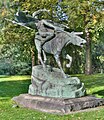Stephan Sinding
Stephan Sinding | |
|---|---|
Realism |
Stephan Abel Sinding (4 August 1846 – 23 January 1922) was a Norwegian-Danish sculptor. He moved to Copenhagen in 1883 and had his breakthrough the same year. In 1890 he obtained Danish citizenship. In 1910 he settled in Paris where he lived and worked until his death in 1922.[1]
Early life and education

Stephan Abel Sinding was born in
Sinding first embarked on law studies in Christiania but broke off to instead pursue a career in the arts. He took drawing and modeling classes first at the Royal School of Drawing in Christiania and then studied privately with sculptor Albert Wolff in Berlin. Sinding spent his adult life working in different places mostly Rome, Copenhagen, and finally Paris. [4]
From 1874 to 1875 he studied in
Career in Denmark
In 1883 he moved to
Sinding created a number of sculptures, among others Mother in Captivity, which won him the Grand Prix at the Exposition Universelle (1889), Two figures (1889), and Young woman at her husband's body / The Widow (1892). Many of Sinding's sculptures are credited to realism, but together with Danish sculptor Niels Hansen Jacobsen, among others, are by many considered much more in the style of Symbolism. An example of his symbolic work is his sculpture Valkyrjen (the valkyrie), a bronze cast of which stands in Churchill Park in Copenhagen.
Sinding became a titular professor and taught private students in Copenhagen.
Late years in Paris
In 1910 Sinding moved to Paris, where he worked until his death. Assisted by Franz von Jessen, Sinding wrote an autobiography entitled En Billedhuggers Liv (1921). He died in January 1922 in Paris, and was buried at the Père Lachaise Cemetery.[2]
Private life
In May 1885 in Frederiksberg he married actress Anna Elga Augusta Betzonich (1859–1936).[2][6]
Selected works
- Vølund smed, 1873
- Hylas, ca. 1880
- Slaven, 1878,
- Frise, 1891
- Enken, 1892
- Henrik Ibsen, 1899
- Bjørnstjerne Bjørnson, 1899
- Moder Jord, 1900
- Ole Bull, 1901
- Valkyrjen, 1908
- Angelus, 1913
- L'Offrande, 1918
-
Stephan Sinding's Electra statue at Kongens Nytorv in Copenhagen
-
Valkyrjen (1908), Churchill Park, Copenhagen
-
Suddenly a Widow (ca. 1910)
Ny Carlsberg Glyptotek -
Adoration I (ca. 1910)
Ny Carlsberg Glyptotek -
Barbarenmutter (ca. 1910)
-
Statue of Ole Bull (1901)
Bergen, Norway -
Statue of Bjørnstjerne Bjørnson (1899)
National Theatre, Oslo -
Statue of Henrik Ibsen (1899)
National Theatre, Oslo -
Un homme et une femme
-
Captive mother
Ny Carlsberg Glyptotek
References
- ^ Stephan Sinding (Store norske leksikon)
- ^ a b c d Ljøgodt, Knut. "Stephan Sinding". In Helle, Knut (ed.). Norsk biografisk leksikon (in Norwegian). Oslo: Kunnskapsforlaget. Retrieved 9 June 2010.
- Brøgger, A. W.; Jansen, Einar (eds.). Norsk biografisk leksikon(in Norwegian). Vol. 9 (1st ed.). Oslo: Aschehoug. pp. 137–140.
- ^ Julius Middelthun (Store norske leksikon)
- ^ Stephan Sinding/utdypning (Store norske leksikon)
- ^ Ljøgodt, Knut. "Otto Sinding". In Helle, Knut (ed.). Norsk biografisk leksikon (in Norwegian). Oslo: Kunnskapsforlaget. Retrieved 9 June 2010.
Other sources
- Grappe, Georges Stephan Sinding (Paris: Librairie Artistique Internationale. 1920)
- Rapsilber, M. Stephen Sinding (Marquardt & Co. 1910)
External links
- PortraitKatalog, (In German)










